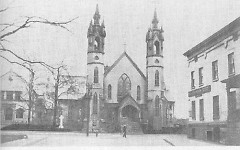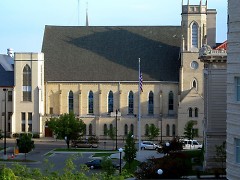Grand Rapids is sometimes called the “City of Churches”. As you walk through the streets of Downtown Grand Rapids you can’t help notice the many beautiful cathedrals sprinkled around this great city. I have limited knowledge about these cathedrals and there history. My curiosity got the better of me, so I looked into the matter.
I wanted to know more about the cities three oldest cathedrals and learn some history about each.
I first talked to Rebecca Smith-Hoffman of Past Perfect Preservation. She informed me that St. Andrews, St. Marks and Park Church were the oldest churches in Grand Rapids. Past Perfect had conducted research and put together a historical document. The document contained the history of 11 of the city’s oldest churches and three parishes from 1848-1960. It explains how the religious institutions historically played an important role in the city's development. The people who made up the congregations contributed physically and financially to the growth and development of many of the city’s schools, colleges, hospitals, and even the public library. The buildings that house the city's churches have played an important role in its physical development. Though the city has changed over the years, the churches remain standing as a symbol of the past.
Father Andreas Viszoczky came to Grand Rapids in 1835 to assist in the development of a parish for white settlers. He ministered to the Odawa Indians and white settlers at a old chapel on the west side of the river. He bought the Godfroy House in 1846 on the corner of Ottawa and Monroe. Construction of a new building on the site began on June 10, 1849. It was built of limestone from the Grand River. On January 14, 1850, a tragic fire damaged the new structure as well as destroying the old house. Construction was completed in August 1850. Father Viszoczky named the church after his patron saint, St. Andrew. After the Germans built their own parish in 1857 the congregation became predominantly Irish.
By the early 1870s, St. Andrew's Church was becoming overcrowded. When Father Patrick Joseph McManus arrived in 1872, he sold the old church and purchased property on Sheldon Boulevard. He picked the location because Irish Catholics live in what is now the Heartside District. The present building was completed on 1874. The architect was John Grady, who was a parishioner of the church. The foundation was partially constructed of limestone from the old building. It was dedicated in 1876 and served a 4,000 member parish at the time.
It became the Cathedral of St. Andrews for the Diocese of West Michigan in 1882. In 1901, lightning struck the spires and caused a fire that destroyed the roof and gutted the interior. The church was rebuilt, partially constructed from the old, into a larger Gothic Revival church. The new building was completed on July 4, 1903. I was baptized there and it still has a fairly large congregation today.
The core of St. Mark’s present building, constructed of Grand River limestone, was erected in 1848. A majority of the financing came from the ladies’ sewing circle. At the time it was the largest Episcopal Church west of Detroit. Nine of the nineteen mayors who served from 1875 to 1906 belonged to St. Mark’s, and they held the office for 20 of those 32 years. In a book written by James Bratt and Christopher Meehan called Gathered at the River, they explain that in the 1870s, St. Mark’s was one of the oldest and most elite churches in town. The authors describe it as “An enclave of affluent Anglo-American business and professional families."
The Rapidian, a program of the 501(c)3 nonprofit Community Media Center, relies on the community’s support to help cover the cost of training reporters and publishing content.
We need your help.
If each of our readers and content creators who values this community platform help support its creation and maintenance, The Rapidian can continue to educate and facilitate a conversation around issues for years to come.
Please support The Rapidian and make a contribution today.




Comments
What a fascinating article! I, too, have been fascinated with these magnificent spires in the sky. They are so majestic and finely crafted featuring such lovely stained-glass windows. Churches as beautiful as these just aren't being built anymore, unfortunately. They are truly a great part of the city's heritage. Thanks for the interesting story!